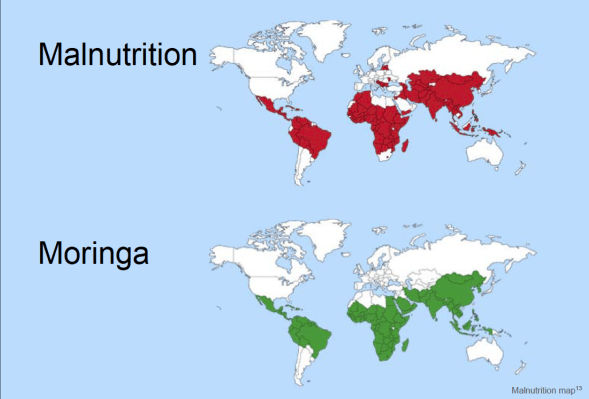Eating Green
By Boaz Oduor, EA Intern, 2008

Moringa’s natural growing regions and regions of malnutrition
IMAGE CREDIT: http://biosilblog.com/tag/moringa/
Boaz was a six-month EA intern in 2008. This is the second half of a presentation he gave during his visit to EA in the fall of 2015. The first part, "Organics4Orphans" can be found in the Spring 2016 issue of the Garden Companion.
At Organics4Orphans (O4O) in Kenya, providing healthy food through GROW BIOINTENSIVE farming isn't the only undertaking they see as part of their outreach to the students and staff. Preventive care through the use of beneficial herbs is making a difference in the school and surrounding area.
In 2008, Douglas, a staff member at O4O, was ill four times and suffered from pneumonia, malaria, and dysentery. The following year he changed to a green diet and started eating fresh vegetables from the garden. He wasn't ill in the 48 months that followed. Boaz shared, "People ask me, 'Is it true that eating fresh vegetables can make a difference in my health?' And I always answer, 'Yes. If you have soil that is healthy, you will have healthy plants, and if you eat them, you'll be healthy.'"
Boaz quotes a scripture that says, "God said, 'I give you every seed-bearing plant on the face of the whole earth and every tree that has fruit with seed in it. They will be yours for food.' From the beginning, God gave us medicines, growing on the earth, and Africa is full of health-giving herbs. But because of advances in medical science and the technical revolution, Africa has abandoned the natural medicine available. It is time for the people of Africa to use what has been given to them for health."
As a result of his interest in herbs for health, in 2009 Boaz took a five-day workshop at Anamed International, a German Christian organization that helps health centers and communities in the Tropics to become more self-reliant in preventing and treating the most common diseases and health complaints. He felt the information would be useful to incorporate into the O4O teachings.
Boaz says one of the most beneficial herbs available in tropical areas where poverty and malnutrition are high is the Moringa tree. The nutrient density of Moringa leaves is very concentrated compared to other foods. It is a miracle tree, providing just what the population needs in depressed areas, such as Kenya.
O4O has two beds of Moringa plants growing at the school. They harvest the leaves and make tea to serve to staff and students, every day as a preventative. Building a defense against diseases is one of the most important things the school can do, since they have to be their own doctor and need to build their immune systems. It makes sense to utilize the locally available resources.
When O4O presents a five-day workshop in the GROW BIOINTENSIVE method, they take Moringa plant cuttings with them, to plant in the garden where the workshop is being held. Once it's been cultivated, community members are encouraged to take cuttings and plant them in their yard. In this way nutrition and health are expanding out from the first handful of plants at the school to the surrounding communities, bringing improved nutrition and better health.
Moringa leaf powder is used to give a side by side comparison with other foods. It is best used fresh for vitamin C. The following nutritional information is found in Anna O'Byrne and Linda Bolton's book, The More of Moringa, available as an eBook, from Amazon.com.
Ounce for ounce, Moringa leaf powder contains 25 times the iron of spinach. Iron is best absorbed in the presence of vitamin C and vitamin B2, both of which are abundant in Moringa leaves.
100 grams of fresh Moringa leaves, or about three cups, provides more than 200 mg of vitamin C. That is nearly four times the vitamin C found in a medium-sized orange.
Just 10 grams of Moringa leaf powder provides over 100% of the required daily B2.
Ounce for ounce, Moringa leaf powder provides 200 mg of calcium which is equal to four times the calcium found in milk.
Calorie for calorie, Moringa is as dense in protein as steak. 20 grams of Moringa leaf powder delivers over 5 grams of protein, with all nine essential amino acids!
Related Story: The Might Moringa - Grow Your Own!
top | Newsletter Home | Article Index | Archive

|



